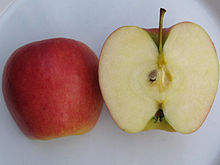Ambrosia (apple)
| Malus domestica 'Ambrosia' | |
|---|---|
 | |
| Cultivar | 'Ambrosia' |
| Origin | |
'Ambrosia' is a
Description
The fruit is medium to large, weighing about 215 grams (0.474 lb), and has mostly red, glossy colouration, with yellow patches. It has cream-coloured, firm meat with a sweet flavour reminiscent of pear and low
Ambrosia is most common in British Columbia, where it was discovered, and is the third most-produced apple in the province. It is also being produced in Ontario and Nova Scotia, as well as many other places around the world.[5]
Parentage
Parentage is suspected to be '
Patent
Ambrosia is a "club" variety of apple, in which a cultivar is patented by an organization that sets quality standards and provides marketing, while production is limited to club members.[7] The name was never trademarked, and the patent has expired in Canada and the United States.[8][9] Centralized control allowed limitation of color variation to pink/red, as the variety would color differently in warmer climates.[8][7][9] The patent expired in Canada in 2015, in the United States in 2017, and in Chile in 2021.[10] It remains active in many other countries until as late as 2034.[8] While under patent in Canada, the Mennells obtained plant breeders rights, and all growers were allowed, paying a royalty of C$2 per tree planting.[8] While under patent in the US, growers paid the lesser of US$1 per tree planting or US$1,000 per acre, and a US$1,000 franchise fee.[8]
See also
- List of Canadian inventions and discoveries
- Jubilee apple
- McIntosh (apple)
- Spartan (apple)
References
- ^ "Ambrosia®". Apples. Okanagan Plant Improvement Corporation (PICO). Retrieved 2012-01-15.
- ^ "The Ambrosia Apple Story: A Delicious, Home-Grown Original". bctree.com.
- ^ "Ambrosia Apple". British Columbia: Ministry of Agriculture. Retrieved 2012-01-15.
- ^ Ltd, Orange Pippin. "Apple - Ambrosia - tasting notes, identification, reviews". Orange Pippin - all about apples and orchards. Retrieved 2016-12-02.
- ^ "Ambrosia Apples in Canada - Frequently Asked Questions". Ambrosia Apples. Archived from the original on 2016-12-02. Retrieved 2016-12-02.
- ^ "Patent USPP10789 - Apple tree named 'Ambrosia'". google.com.
- ^ a b Brown, Susan; Maloney, K. E. (2009). "Making Sense of New Apple Varieties, Trademarks and Clubs: Current Status". New York Fruit Quarterly (17).
- ^ a b c d e Warner, Geraldine (2015-06-18). "Ambrosia Restrictions to End". Good Fruit Grower. Retrieved 2018-06-06.
- ^ a b Courtney, Ross (2017-06-07). "Ambrosia apple patent opens up: 20-year U.S. patent ends on popular club variety". Good Fruit Grower.
- ^ "Ambrosia apple patent will still be valid outside North America". Fresh Fruit Portal. 2017-06-09. Retrieved 2018-06-06.
